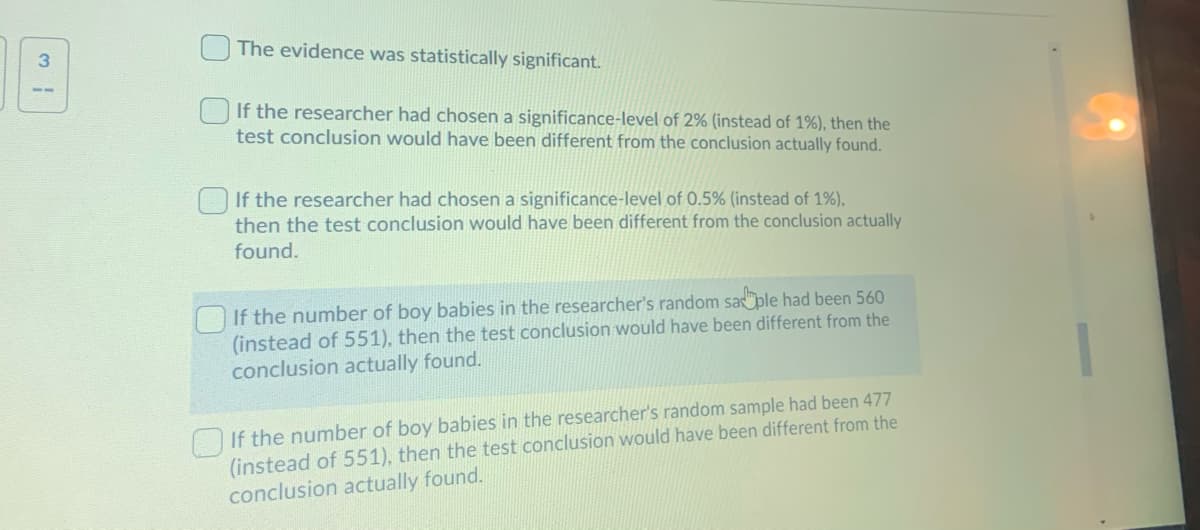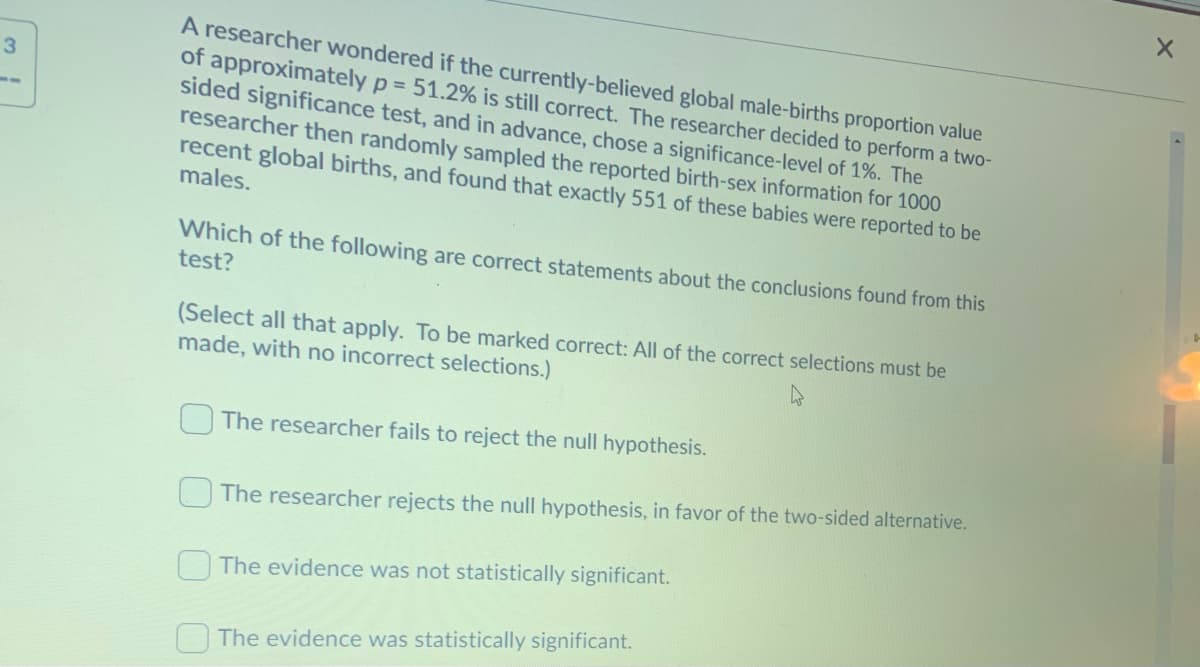A researcher wondered if the currently-believed global male-births proportion value of approximately p = 51.2% is still correct. The researcher decided to perform a two- sided significance test, and in advance, chose a significance-level of 1%. The researcher then randomly sampled the reported birth-sex information for 1000 recent global births, and found that exactly 551 of these babies were reported to be males. Which of the following are correct statements about the conclusions found from this test? (Select all that apply. To be marked correct: All of the correct selections must be made, with no incorrect selections.) The researcher fails to reject the null hypothesis. The researcher rejects the null hypothesis, in favor of the two-sided alternative. The evidence was not statistically significant. The evidence was statistically significant.
A researcher wondered if the currently-believed global male-births proportion value of approximately p = 51.2% is still correct. The researcher decided to perform a two- sided significance test, and in advance, chose a significance-level of 1%. The researcher then randomly sampled the reported birth-sex information for 1000 recent global births, and found that exactly 551 of these babies were reported to be males. Which of the following are correct statements about the conclusions found from this test? (Select all that apply. To be marked correct: All of the correct selections must be made, with no incorrect selections.) The researcher fails to reject the null hypothesis. The researcher rejects the null hypothesis, in favor of the two-sided alternative. The evidence was not statistically significant. The evidence was statistically significant.
College Algebra (MindTap Course List)
12th Edition
ISBN:9781305652231
Author:R. David Gustafson, Jeff Hughes
Publisher:R. David Gustafson, Jeff Hughes
Chapter8: Sequences, Series, And Probability
Section8.7: Probability
Problem 58E: What is meant by the sample space of an experiment?
Related questions
Topic Video
Question

Transcribed Image Text:The evidence was statistically significant.
3.
If the researcher had chosen a significance-level of 2% (instead of 1%), then the
test conclusion would have been different from the conclusion actually found.
If the researcher had chosen a significance-level of 0.5% (instead of 1%),
then the test conclusion would have been different from the conclusion actually
found.
If the number of boy babies in the researcher's random saple had been 560
(instead of 551), then the test conclusion would have been different from the
conclusion actually found.
OIf the number of boy babies in the researcher's random sample had been 477
(instead of 551), then the test conclusion would have been different from the
conclusion actually found.

Transcribed Image Text:A researcher wondered if the currently-believed global male-births proportion value
of approximately p = 51.2% is still correct. The researcher decided to perform a two-
sided significance test, and in advance, chose a significance-level of 1%. The
researcher then randomly sampled the reported birth-sex information for 1000
recent global births, and found that exactly 551 of these babies were reported to be
males.
Which of the following are correct statements about the conclusions found from this
test?
(Select all that apply. To be marked correct: All of the correct selections must be
made, with no incorrect selections.)
The researcher fails to reject the null hypothesis.
The researcher rejects the null hypothesis, in favor of the two-sided alternative.
The evidence was not statistically significant.
The evidence was statistically significant.
Expert Solution
This question has been solved!
Explore an expertly crafted, step-by-step solution for a thorough understanding of key concepts.
This is a popular solution!
Trending now
This is a popular solution!
Step by step
Solved in 2 steps with 2 images

Knowledge Booster
Learn more about
Need a deep-dive on the concept behind this application? Look no further. Learn more about this topic, statistics and related others by exploring similar questions and additional content below.Recommended textbooks for you

College Algebra (MindTap Course List)
Algebra
ISBN:
9781305652231
Author:
R. David Gustafson, Jeff Hughes
Publisher:
Cengage Learning

College Algebra (MindTap Course List)
Algebra
ISBN:
9781305652231
Author:
R. David Gustafson, Jeff Hughes
Publisher:
Cengage Learning